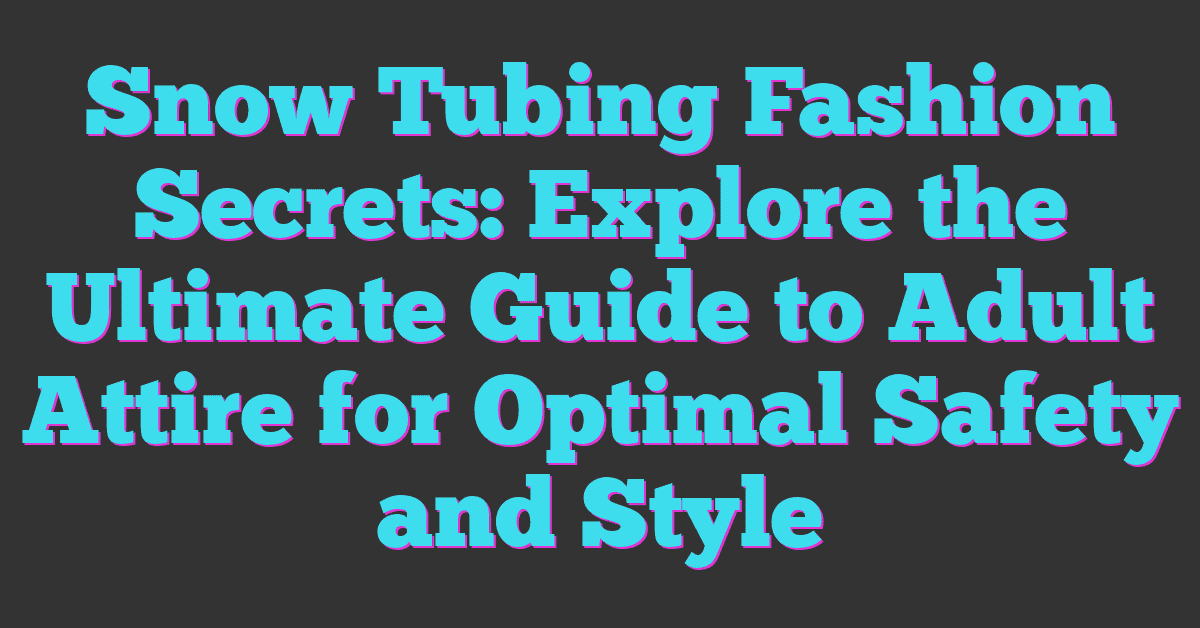Are you planning a fun-filled day of snow tubing? Whether you’re a seasoned snow tuber or trying it for the first time, it’s essential to dress appropriately for the activity. In this article, we’ll explore what adults should wear for snow tubing to ensure maximum comfort and enjoyment. From base layers to outerwear, we’ve got you covered with practical tips and suggestions. So, let’s dive in and discover the perfect snow tubing attire for adults!

When it comes to snow tubing, wearing the right clothing is crucial to staying warm and comfortable throughout the day. Layering is key to regulating your body temperature and adapting to changing weather conditions. Start with a moisture-wicking base layer that will keep you dry and prevent chills. Next, add an insulating mid-layer, such as a fleece or down jacket, to trap heat and provide extra warmth. Finally, top it off with a waterproof and windproof outer layer to protect you from snow and wind.
In addition to layering, don’t forget about your extremities. Keeping your hands, feet, and head warm is essential for an enjoyable snow tubing experience. Invest in a good pair of waterproof gloves or mittens to keep your hands dry and insulated. Wear thick socks and waterproof boots to keep your feet warm and protected from the cold snow. Lastly, don’t forget to wear a snug-fitting hat or a helmet to retain heat and prevent heat loss through your head.
Dressing for Snow Tubing: What Do Adults Wear?
As an avid snow sports enthusiast, dressing appropriately for snow tubing is crucial to ensure maximum comfort and enjoyment on the slopes. The right clothing can make all the difference in your experience, allowing you to stay warm, dry, and ready for countless thrilling runs down the hill.
When it comes to dressing for snow tubing, layering is key. Layering not only helps regulate your body temperature, but it also allows you to easily adapt to changing weather conditions. Here’s a breakdown of what adults should wear to stay comfortable while snow tubing:
1. Moisture-Wicking Base Layer
Start with a moisture-wicking base layer that fits snugly against your skin. This will help wick away sweat and keep you dry throughout your snow tubing adventure. Look for base layers made of synthetic materials like polyester or merino wool, as they are excellent at moisture management.
2. Insulating Mid-Layer
Next, add an insulating mid-layer to trap the warmth and provide an extra barrier against the cold. This layer can be a fleece jacket or a lightweight down sweater. Opt for materials that provide insulation without adding bulk, so you can easily move around on the snow.
3. Waterproof and Windproof Outer Layer
To protect yourself from the elements, top it off with a waterproof and windproof outer layer. Look for a snowboarding or skiing jacket and pants that are designed to keep you dry. These garments should have taped seams, a water-resistant coating, and adjustable cuffs and hems to keep snow and wind out.
4. Essential Winter Accessories
Don’t forget to keep your extremities warm! Wear waterproof gloves or mittens to protect your hands from the cold and snow. Thick wool or thermal socks paired with waterproof boots will keep your feet toasty and dry. Finally, don’t forget a snug-fitting hat or helmet to retain heat and protect your head.
Remember, always check the weather conditions and dress accordingly. Layering allows you to adjust your clothing as needed throughout the day. It’s better to start off with more layers and remove them if you get too warm than to be caught unprepared.
Prioritize Warmth and Comfort: Layering is Key
When it comes to snow tubing, prioritizing warmth and comfort should be at the top of your list. As an avid snow sports enthusiast, I can tell you that layering is the key to staying cozy and enjoying your time on the slopes.
Layering not only helps regulate your body temperature but also allows you to adapt to changing weather conditions. Here’s a breakdown of how to layer for snow tubing:
- Moisture-Wicking Base Layer: Start with a moisture-wicking base layer that sits next to your skin. This will help keep you dry by wicking away sweat and moisture. Look for thermal tops and bottoms made of synthetic materials like polyester or merino wool, which are excellent at moisture management.
- Insulating Mid-Layer: On top of your base layer, add an insulating mid-layer. This layer is responsible for trapping heat close to your body, providing additional warmth. Choose a fleece jacket or a lightweight down vest to maximize insulation without sacrificing mobility.
- Waterproof and Windproof Outer Layer: To protect yourself from the elements, invest in a waterproof and windproof outer layer. Look for snow pants and jackets made with breathable materials that provide excellent protection against snow, wind, and moisture. GORE-TEX or similar fabrics are great choices.
To ensure maximum comfort, make sure your outer layer has additional features like adjustable cuffs, a snow skirt, and a helmet-compatible hood to keep the snow out and provide extra protection.
Remember to check the weather conditions before heading out and adjust your layers accordingly. If it’s particularly cold, consider adding an extra insulating layer or wearing thicker fleece-lined pants. Conversely, if the temperature rises, don’t hesitate to remove a layer to avoid overheating.
The Top Layer: Choosing the Right Jacket or Coat
When it comes to snow tubing, having the right jacket or coat can make all the difference in keeping you warm and dry as you glide down the slopes. As an avid snow sports enthusiast, I can tell you that choosing the right top layer is crucial for a comfortable and enjoyable experience.
1. Waterproof and Breathable
First and foremost, look for a jacket or coat that is both waterproof and breathable. This will help you stay dry by repelling snow and moisture, while also allowing sweat and body heat to escape. A good waterproof rating is essential to keep you protected from snow and water, while breathability ensures that you don’t get overheated during your tubing adventure.
2. Insulation
Consider the insulation of the jacket or coat. You’ll want something that offers enough warmth without feeling bulky or restricting your movement. Look for jackets that have synthetic insulation or down fill. Synthetic insulation is great for snow tubing as it retains its thermal properties even if it gets wet. Down fill, on the other hand, provides superior warmth but can lose its insulation when wet.
3. Fit and Features
Opt for a jacket or coat that has a comfortable fit and features that suit your needs. A slightly loose fit allows for extra layers underneath, while still providing freedom of movement. Look for adjustable cuffs, a hem drawcord, and a high collar to keep out any drafts. Additionally, consider features like a detachable hood, ventilation zippers, and multiple pockets for added convenience.
Remember, it’s essential to check the weather conditions before heading out, as it will determine which type of top layer will best suit the day. You might need a heavier, waterproof jacket for colder and wetter conditions, or a lighter, more breathable option for milder weather.
Choosing the right jacket or coat as your top layer is key to staying warm, dry, and comfortable during your snow tubing adventure. So, make sure to invest in a high-quality, functional piece that will enhance your experience on the slopes.
Don’t Neglect Your Bottom Half: Pants and Leggings
Now that we’ve covered the importance of choosing the right jacket for snow tubing, let’s move on to another crucial aspect of your outfit: your pants and leggings. When it comes to winter sports, it’s essential to keep your bottom half warm and protected from the elements. As a passionate snow sports enthusiast, you know that finding the right pants or leggings can make all the difference in your comfort and performance on the slopes.
1. Opt for Waterproof and Insulated Pants: When selecting your snow tubing bottoms, prioritize pants or leggings that are waterproof and have insulation to keep you warm. Look for materials like Gore-Tex or other waterproof fabrics that will keep you dry even if you take a tumble in the snow. Insulated options, such as those with synthetic or down-fill, will provide added warmth without sacrificing mobility.
2. Seek Breathable Fabrics: While it’s important to keep warm, it’s equally important not to overheat. Look for pants or leggings made of breathable fabrics that allow moisture to escape, preventing you from feeling sweaty and uncomfortable. This will help regulate your body temperature and keep you comfortable throughout your snow tubing adventure.
3. Consider Features and Fit: The right features and fit can greatly enhance your snow tubing experience. Look for pants or leggings with features like reinforced knees and seat, adjustable waistbands, and ankle gaiters to keep the snow out. Additionally, make sure the fit allows for a full range of motion, allowing you to move freely while tubing down the slopes.
4. Layering is Key: Remember, layering can provide extra warmth and flexibility. Consider wearing thermal leggings or base layers underneath your pants for added insulation. This way, you can adjust your clothing according to the weather conditions and your activity level.
Protecting Your Extremities: Gloves, Hats, and Scarves
Now that we’ve covered the essentials of choosing the right jacket and pants for snow tubing, let’s move on to an equally important topic: protecting your extremities. When you’re out in the cold, it’s crucial to keep your hands, head, and neck warm. As an avid snow sports enthusiast, I can’t stress enough how much of a difference the right gloves, hats, and scarves can make in your overall comfort and enjoyment.
Gloves
When it comes to gloves for snow tubing, you’ll want a pair that strikes the perfect balance between warmth and dexterity. Look for gloves that are insulated and waterproof to keep your hands toasty and dry. Opt for gloves with a snug fit to help maintain dexterity and control while holding onto your tube. Adjustable wrist straps are also a great feature to ensure a secure fit and prevent snow from sneaking in.
Hats
A good hat is essential for keeping your head warm and comfortable in the chilly winter air. Look for a hat that covers your ears and is made from a warm, insulating material like wool or fleece. To add extra warmth, consider a hat with a fleece lining or built-in ear flaps. Don’t forget to choose a hat that fits snugly to prevent it from slipping off during your thrilling descents.
Scarves
To protect your neck from the cold wind, a scarf is a must-have accessory for snow tubing. Opt for a scarf made of a warm and breathable fabric like merino wool or fleece. These materials will help keep you cozy while allowing moisture to escape. Keep in mind that longer scarves can get in the way, so consider a shorter, adjustable neck warmer or a snood that can be easily pulled up to cover your face if needed.
Keeping Your Feet Warm: Socks and Boots
As an avid snow sports enthusiast, you know that keeping your feet warm and comfortable is essential when you’re out enjoying winter activities like snow tubing. The right choice of socks and boots can make all the difference in ensuring that your feet stay cozy and dry throughout your adventure on the slopes.
Choosing the Right Socks
When it comes to socks for snow tubing, it’s important to opt for ones that are warm, moisture-wicking, and breathable. Look for socks made of materials like merino wool or synthetic blends with moisture-wicking properties. These fabrics will help keep your feet dry by wicking away sweat and moisture.
Consider wearing thicker, cushioned socks for added insulation and comfort. They provide extra warmth without sacrificing breathability. Make sure the socks fit snugly without being too tight, as this can restrict circulation and cause discomfort. Avoid cotton socks, as they tend to absorb moisture and can leave your feet feeling damp and cold.
Choosing the Right Boots
When it comes to choosing boots for snow tubing, you’ll want to focus on finding a pair that is waterproof, insulated, and provides good traction. Look for boots specifically designed for winter sports, as they often have features that cater to the demands of cold and snowy conditions.
Insulation is key in keeping your feet warm, so opt for boots with Thinsulate or similar insulation technologies. These materials trap heat effectively, providing excellent warmth without bulkiness. Additionally, check for boots with a waterproof outer shell to keep your feet dry when encountering snow or slush.
Make sure the boots fit properly, with enough room to wiggle your toes comfortably. They should feel snug, offering support and stability for your feet. Look for boots with a good tread pattern on the sole to provide traction and prevent slipping on icy surfaces.
Goggles or Sunglasses: Protecting Your Eyes
As an avid snow sports enthusiast, protecting your eyes should be one of your top priorities when snow tubing. The combination of the sun’s reflection off the snow and the cold winds can cause some serious eye strain and even damage. That’s why it’s crucial to choose the right eyewear for your snow tubing adventure.
Goggles are an excellent choice for snow tubing. They provide full coverage and protect your eyes from the elements. Look for goggles with 100% UV protection to shield your eyes from harmful rays. The lenses should also be polarized to reduce glare, allowing you to see clearly even in bright conditions. Make sure the goggles fit snugly around your face to prevent any snow or wind from entering.
If goggles aren’t your preference, you can also opt for sunglasses. Look for sunglasses that offer UV400 protection to block out 100% of UVA and UVB rays. Polarized lenses are also recommended for reducing glare. Choose a pair that fits comfortably on your face and doesn’t slip off easily, especially when you’re bouncing around on the snow tube.
Both goggles and sunglasses should have anti-fog properties to prevent your lenses from misting up, giving you clear vision throughout your snow tubing experience. Some eyewear even comes with ventilation systems to promote airflow and reduce the risk of fogging.
Remember, protecting your eyes while snow tubing isn’t just about functionality, but also about having a stylish accessory that complements your winter gear. Choose eyewear that matches your personal style and expresses your love for winter sports.
Whether you choose goggles or sunglasses, prioritize eye safety and comfort when hitting the slopes for snow tubing. With the right eyewear, you can fully enjoy the thrill of the ride while keeping your eyes protected from the elements.
Dressing for Safety: Helmets and Protective Gear
As an avid snow sports enthusiast, you know that safety should always be your top priority when hitting the slopes. Snow tubing is no exception, and it’s important to dress appropriately to ensure a safe and enjoyable experience. So, let’s talk about the essential protective gear, starting with helmets.
Helmets are a must-have when snow tubing, as they provide vital protection for your head in case of falls or collisions. Look for helmets that are specifically designed for winter sports, as they offer better insulation and coverage. Make sure your helmet fits snugly but comfortably and has adjustable straps to keep it in place. Remember, safety should never be compromised.
Protective eyewear is equally important when snow tubing. Goggles with 100% UV protection and polarized lenses are the ideal choice. These goggles not only shield your eyes from harmful sunrays but also reduce glare, giving you better visibility on the slopes. Anti-fog properties are a must to ensure clear vision throughout your adventure. And let’s not forget about comfort – opt for goggles that fit well and won’t slide down your face.
Let’s move on to protective clothing. Dressing in layers is key to staying warm and comfortable during your snow tubing escapades. Start with a moisture-wicking base layer to keep your skin dry. Add a insulating layer like a fleece or down jacket for warmth. Finally, layer up with a waterproof and wind-resistant outer shell to protect you from the elements. Don’t forget to wear water-resistant gloves to keep your hands dry and warm.
Lastly, proper footwear is crucial for a successful snow tubing experience. Waterproof boots, preferably with insulation, will keep your feet warm and dry. Look for boots with good traction to prevent slipping while walking to and from the tubing area.
Conclusion: Stay Warm and Cozy on the Slopes
Now that you have all the tips and tricks for dressing appropriately for snow tubing, you can hit the slopes with confidence. Remember to prioritize your eye safety by wearing goggles or sunglasses with 100% UV protection and polarized lenses. Don’t forget to choose eyewear that is anti-fog and provides a comfortable fit.
In addition to protecting your eyes, it’s crucial to safeguard your head by wearing a helmet. This will ensure that you stay safe while enjoying the thrill of snow tubing.
To stay warm and comfortable, dress in layers. Start with moisture-wicking base layers to keep sweat away from your skin. Layer on insulating garments for added warmth, and finish off with a waterproof outer shell to keep you dry in the snow.
Lastly, don’t overlook the importance of proper footwear. Opt for waterproof boots with good traction to keep your feet warm and prevent any slips or falls.
By following these tips, you’ll be well-prepared to have a fantastic time snow tubing while staying warm and cozy on the slopes. So grab your gear, bundle up, and get ready for an exhilarating adventure in the winter wonderland!











